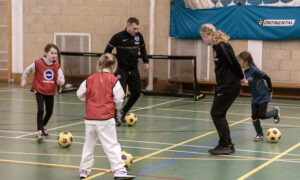We’ve been interviewing Y6 and Y11 girls for scholarships this week and what a pleasure it has been. It’s wonderful to hear about the different passions and interests girls have: what they do beyond the school curriculum; the sports they play; the books they like to read. Coincidentally ‘The Monitor 2017’ report from Childwise was published this week. It’s an annual report based on online surveys with 2,000 schoolchildren.
Its findings suggest there has been a welcome rise in the proportion of girls aged 15 and 16 taking part in sport at school, with three in four now participating, compared with just half in 2015.There were also some interesting statistics about children’s and young people’s use of mobiles: 31% said they had to check their devices every few minutes, rising to 42% of 17- to 18-year-olds, while a quarter of nine- to 16-year-olds admitted to turning off or getting round parental safety controls online. Even among children at primary school, the survey found that mobiles were taking over from tablets.The mobile phone is increasingly becoming a preferred go-to multimedia gadget for children overall and for primary-aged children particularly, exposure to what a tablet can offer has left them wanting more, especially when they are outside the home.
Young people’s reading habits are also changing. The report found that 9-16 year-olds spend half an hour reading printed materials such as books, comics and magazines every day, and half an hour reading online content like blogs, fan fiction and online magazines. However, the way children read changes as they hit their teenage years: 13-16 year-olds spend double the amount of time reading online. This is likely due to higher levels of mobile phone ownership according to Childwise research executive Helena Dare-Edwards. “On a mobile, they can access short-form content anytime, anywhere, and links to external sites are continually shared and circulated through social media. Older children are also more likely to have fewer restrictions on the websites they can visit and more freedom in the amount of time they spend online.”
Teenagers are also more likely to say they don’t read at all – as a third of 15-16 year-olds said they never read, compared to 5% of 9-10 year-olds. However, Dare-Edwards said the internet and online materials could help encourage adolescents to read. “Recent years have seen a steady decline in the number of children reading for pleasure but it could be argued that online reading is bridging this gap, particularly among teenagers who begin to move away from books and magazines.”
There are clearly many changes taking place in the ways young people spend their time outside lessons. In school we try to adapt to these changes in order to make the best of links between the learning students do in lessons and different learning experiences outside school –our Firefly platform is an obvious example. But the most important thing of all, in my view, is that every student is enabled to find her passion or interest; something she can enjoy beyond school and into adulthood. I’m keen that no one misses the opportunities afforded by our school in terms of developing those interests, whether it be in sport, reading, drama, dance, computing, debating, art, philosophy, ecology or in an area we haven’t yet developed (all new ideas welcome). Form tutors and pastoral heads regularly talk to girls about their outside interests and monitor those girls who don’t seem engaged. If any parent or student has a question or concern about extra-curricular involvement, please do contact your Head of School or Mrs Parsons or Ms Fox, all of whom will be pleased to help.


